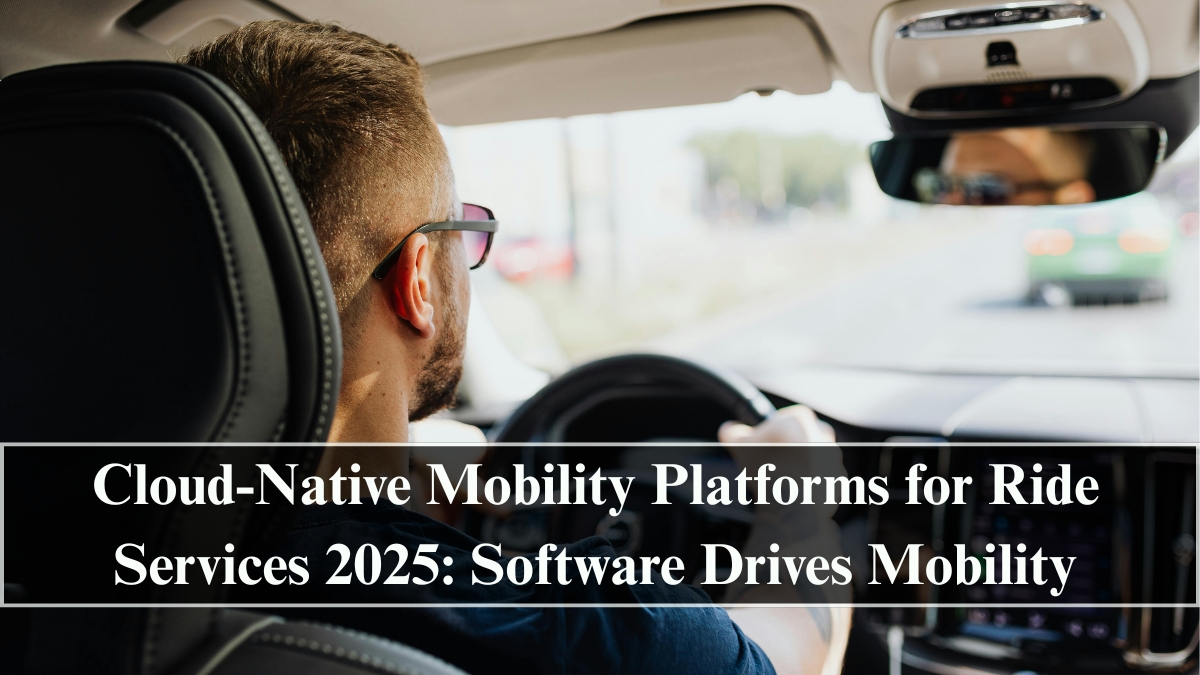In 2025, mobility is no longer defined by vehicles alone — it’s defined by cloud-native software ecosystems that connect millions of rides, drivers, and passengers in real time. As the backbone of modern ride-hailing and shared mobility networks, cloud-native mobility platforms are driving an era where transportation runs on code as much as it does on wheels.
From managing fleets to predicting demand and optimizing routes, cloud infrastructure now underpins how cities move. With automation, AI, and edge computing integrated into the mobility ecosystem, cloud-native platforms are enabling transportation to become faster, more efficient, and infinitely scalable.

What Are Cloud-Native Mobility Platforms?
A cloud-native mobility platform is a digital architecture designed to operate entirely within the cloud, using microservices, APIs, and containerized software to deliver seamless mobility operations.
Unlike legacy systems, these platforms are:
-
Scalable: They handle millions of rides simultaneously across geographies.
-
Flexible: They integrate easily with payment gateways, mapping APIs, and telematics systems.
-
Resilient: They can recover automatically from failures or traffic spikes.
-
Intelligent: AI-driven algorithms improve dispatching, pricing, and route optimization.
By running core ride services on cloud environments, mobility providers gain real-time visibility into fleet performance, user demand, and operational efficiency — a critical advantage in the fast-evolving transportation sector.
The Role of Cloud Technology in Mobility Services
Cloud-native infrastructure has become the digital nervous system of ride-hailing, car-sharing, and fleet management services.
Core functions supported by cloud platforms include:
-
Dynamic Ride Matching: AI and real-time analytics match passengers with the nearest available vehicles.
-
Smart Routing: Cloud servers process live traffic and weather data for the most efficient path.
-
Demand Forecasting: Predictive models anticipate ride volumes by time, location, and event.
-
Fleet Tracking & Maintenance: IoT sensors transmit live vehicle diagnostics to cloud dashboards.
-
Payments & Security: Cloud-based APIs ensure safe, instant transactions across multiple currencies.
These technologies enable operators like Uber, Lyft, and Ola to scale globally while maintaining high reliability and low latency — even during peak hours.
Key Technologies Powering Cloud-Native Mobility
In 2025, cloud-native platforms rely on a fusion of AI, IoT, and edge computing to manage complex mobility networks.
Some of the leading technologies include:
-
Kubernetes & Docker: Manage microservices architecture for scalable deployment.
-
Edge Computing Nodes: Process data closer to vehicles for faster decision-making.
-
AI-Powered Analytics: Forecast ride demand, traffic conditions, and user preferences.
-
API-First Design: Enables easy integration with third-party services like insurance, EV charging, and navigation.
-
Serverless Computing: Reduces costs by allocating resources only when tasks are running.
This combination of cloud and AI enables autonomous scaling — allowing mobility providers to expand from one city to another with minimal infrastructure overhead.
Leading Examples of Cloud-Native Mobility Platforms
The mobility revolution is being driven by global leaders and emerging startups that have adopted cloud-first architectures:
-
Uber Cloud Architecture: Uses microservices on AWS and Google Cloud to manage millions of daily rides.
-
Lyft’s Kubernetes Fleet System: Orchestrates data from GPS, mapping, and payments in real time.
-
Grab Mobility Cloud: Powers multi-modal transport services across Southeast Asia with regional data centers.
-
Ola HyperCloud: Enables predictive maintenance and analytics for EV ride fleets.
-
Didi Chuxing’s Smart Mobility Brain: Uses AI-driven orchestration for dynamic pricing and traffic prediction.
Even traditional automakers are building Mobility-as-a-Service (MaaS) platforms based on similar cloud-native principles to power subscription cars and autonomous ride fleets.
Benefits of Cloud-Native Mobility Platforms
The advantages of adopting cloud-native architectures extend across all levels of mobility operations:
-
Scalability: Seamlessly supports growing fleets and new cities without manual intervention.
-
Cost Efficiency: Optimizes infrastructure usage through pay-as-you-go models.
-
Faster Innovation: Enables continuous software deployment without service downtime.
-
Improved User Experience: Provides smoother app performance and real-time ride tracking.
-
Data-Driven Decisions: Aggregates fleet and user data for actionable business insights.
As ride services continue to expand, cloud infrastructure ensures that mobility providers can adapt dynamically to both demand surges and technological evolution.
The Future of Cloud-Driven Mobility
By 2030, mobility ecosystems will become fully cloud-integrated, where every car, scooter, and bus communicates seamlessly with urban infrastructure through shared data platforms.
Emerging trends shaping the next decade include:
-
AI-based fleet orchestration that self-adjusts supply to meet passenger demand.
-
Blockchain-backed ride authentication for enhanced transparency.
-
Integration of autonomous vehicles into cloud-managed dispatch systems.
-
Global “mobility clouds” linking EV charging networks, insurance, and traffic systems.
As software becomes the engine of transportation, cloud-native design will power a new era of mobility intelligence, where efficiency and sustainability are driven entirely by digital architecture.
FAQs
What is a cloud-native mobility platform?
It’s a software ecosystem that runs mobility operations — like ride-hailing or car-sharing — entirely through scalable cloud infrastructure and APIs.
How does cloud computing improve ride services?
It allows real-time tracking, dynamic ride matching, smart routing, and instant scalability across cities.
Which companies are leading in cloud-based mobility solutions?
Uber, Lyft, Grab, Ola, and Didi are top adopters, using AI-powered cloud platforms for global fleet management.
Why is cloud-native architecture better than traditional systems?
It’s more flexible, cost-efficient, and scalable, enabling constant innovation without service interruption.
What’s the future of cloud mobility?
By 2030, cloud-native systems will connect vehicles, infrastructure, and energy networks into unified, data-driven mobility ecosystems.
Click here to know more.
